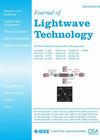Multifunctional Ultraviolet-C Micro-LED With Monolithically Integrated Photodetector for Optical Wireless Communication
IF 4.8
1区 工程技术
Q2 ENGINEERING, ELECTRICAL & ELECTRONIC
引用次数: 7
Abstract
In this paper, a multifunctional ultraviolet-C (UVC) micro-LED with monolithically integrated photodetector (PD) based on AlGaN multiple quantum wells (MQWs) was fabricated. We designed and integrated UVC LED with sizes of 40 and 300无线光通信用单片集成光电探测器多功能紫外- c微型led
本文制备了一种基于AlGaN多量子阱(MQW)的具有单片集成光电探测器(PD)的多功能紫外线-C(UVC)微LED。我们在单个芯片上设计并集成了尺寸分别为40和300$\mu$m的UVC LED,该LED在277nm处发射,也用作PD,并进一步研究了片上实时光电检测的性能。一个LED产生的光电流可以很好地反映相邻LED的光输出功率。此外,40$\mu$m UVC微型LED和300$\mu$m UVC LED在高速UVC通信中都发挥着重要作用,40$\ mu$m微型LED的创纪录带宽为497.58MHz,300$\ mu$m LED的创记录带宽为467.38MHz,在高速UVC通信中互为备用光源。基于带预均衡的16进制正交调幅正交频分复用(16-QAM-OFDM),在1m链路上实现了40$\mu$m微型LED 1.6Gbps和300$\mu$m LED 1.21Gbps的数据传输速率。多功能UVC微型LED单片集成PD,无需外部PD来监测发光的波动,为各种应用提供了高稳定性,例如用于6G通信的空间无线通信。
本文章由计算机程序翻译,如有差异,请以英文原文为准。
求助全文
约1分钟内获得全文
求助全文
来源期刊

Journal of Lightwave Technology
工程技术-工程:电子与电气
CiteScore
9.40
自引率
14.90%
发文量
936
审稿时长
3.9 months
期刊介绍:
The Journal of Lightwave Technology is comprised of original contributions, both regular papers and letters, covering work in all aspects of optical guided-wave science, technology, and engineering. Manuscripts are solicited which report original theoretical and/or experimental results which advance the technological base of guided-wave technology. Tutorial and review papers are by invitation only. Topics of interest include the following: fiber and cable technologies, active and passive guided-wave componentry (light sources, detectors, repeaters, switches, fiber sensors, etc.); integrated optics and optoelectronics; and systems, subsystems, new applications and unique field trials. System oriented manuscripts should be concerned with systems which perform a function not previously available, out-perform previously established systems, or represent enhancements in the state of the art in general.
 求助内容:
求助内容: 应助结果提醒方式:
应助结果提醒方式:


